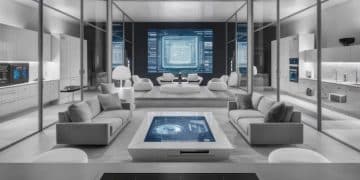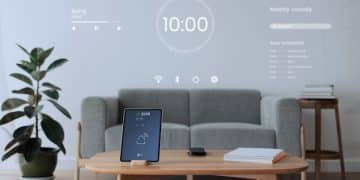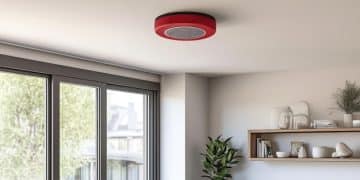Smart Home Trends 2025: Latest Innovations in Automation
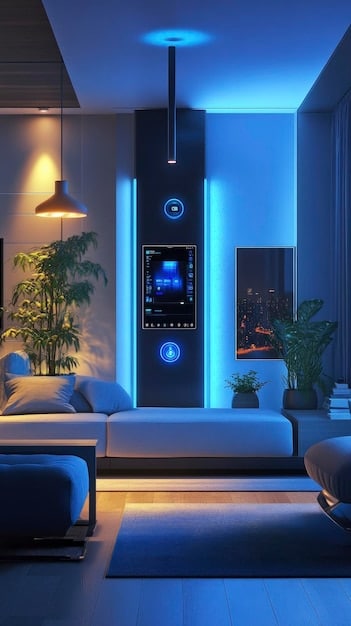
Anúncios
The year 2025 ushers in a new era for smart homes, characterized by advanced AI integration, enhanced interoperability, and a heightened focus on personalized and sustainable living, transforming daily routines through seamless automation and predictive intelligence.
In a world constantly evolving, our homes are no exception. The concept of a “smart home” has transitioned from futuristic fantasy to a tangible reality, with continuous advancements shaping how we live. This article delves into the most compelling Smart Home Trends: The Latest Innovations in Home Automation for 2025, exploring what the near future holds for connected living spaces.
The Dawn of Proactive AI and Predictive Automation
The smart home landscape in 2025 is increasingly defined by artificial intelligence (AI) that goes beyond simple voice commands. We are witnessing a significant shift towards proactive AI systems capable of anticipating resident needs and automating actions before a request is even made. This profound evolution promises to redefine convenience and efficiency within the home environment.
AI is rapidly moving from reactive responses to predictive capabilities. Imagine a home that learns your morning routine: it could automatically adjust the thermostat, brew coffee, and even dim lights in anticipation of your waking up, all without a single command. This level of personalized automation is powered by sophisticated algorithms that analyze patterns of behavior, environmental data, and external factors like weather forecasts or even traffic conditions. The integration of predictive analysis means that smart homes will optimize energy use, enhance security, and elevate comfort levels in ways previously unimaginable.
Advanced Learning Algorithms
The intelligence embedded within smart home systems is becoming more nuanced. Advanced machine learning algorithms are enabling devices to interpret subtle cues and long-term habits.
- Behavioral Pattern Recognition: Systems learn daily routines, such as when occupants typically arrive home, go to sleep, or use specific appliances. This data then informs automated schedules.
- Contextual Awareness: Beyond simple time-based routines, smart homes now consider who is home, what activities are happening, and even external events, tailoring responses accordingly.
- Self-Correction and Optimization: AI routines are not static; they continually refine themselves based on feedback and changing preferences, striving for optimal performance and user satisfaction.
This proactive stance minimizes the need for direct interaction, making the smart home truly intuitive. It understands your preferences and acts on them. For instance, if you consistently raise the temperature at 8 PM, the system will eventually learn to do it automatically, while also considering external factors like current outside temperature to prevent excessive heating.
Seamless Integration with External Data
The true power of proactive AI lies in its ability to synthesize information from various sources. This widespread data integration creates a highly responsive and remarkably adaptive home.
- Weather Predictive Adjustments: Your thermostat may not only learn your preferred temperature but also adjust itself based on the upcoming weather forecast, ensuring comfort while optimizing energy.
- Traffic-Based Home Readiness: If integrated with your navigation app, your home could begin cooling or heating just as you depart from work, ensuring a comfortable arrival.
- Utility Demand Response: Smart appliances linked to the grid can adjust their operation to periods of lower energy demand or cheaper rates, saving money and reducing environmental impact.
These systems learn and adapt without explicit programming, making daily life effortless. This shift represents not just convenience, but a fundamental change in how we interact with our living spaces, turning them into responsive environments that cater to our well-being and efficiency.
In essence, 2025’s smart homes are becoming less about individual devices and more about a cohesive, intelligent ecosystem that anticipates and responds to the ebb and flow of daily life, making our environment truly work for us, often without us even realizing it. The focus is emphatically on creating a seamless, intuitive, and highly personalized living experience where technology fades into the background, operating quietly and efficiently.
Hyper-Personalization and Adaptive Environments
The concept of personalization in smart homes is reaching unprecedented levels in 2025. It’s no longer just about setting preferred temperatures or lighting scenes; it’s about creating an environment that fluidly adapts to the unique needs and moods of each occupant, recognizing their presence and adjusting every facet of the home accordingly. This advanced level of customization is driven by sophisticated sensor technology and AI.
Hyper-personalization is about crafting an experience unique to each individual. Imagine walking into a room, and the lighting subtly adjusts to your preferred brightness and color temperature, background music queues up your favorite playlist, and even the air quality system optimizes itself based on your pre-set sensitivities. This is the future unfolding right before our eyes, where the home anticipates and caters to individual preferences.
Personalized Comfort Profiles
Each resident can have a distinct comfort profile, encompassing various environmental factors. These profiles optimize the home’s settings for whoever is present.
- Individual Climate Zones: Technologies allow for personalized temperature control in different areas based on who is occupying them.
- Customized Lighting & Sound: Lighting scenes and audio playback can automatically adjust based on facial recognition or wearable tech, setting the perfect ambiance.
- Allergy & Wellness Adjustments: Air purifiers and humidifiers can respond to individual health needs, optimizing indoor air quality for specific allergies or sensitivities.
This level of detail ensures that the home is always perfectly tuned to the specific needs of its inhabitants, improving overall well-being. The home becomes a truly adaptive entity, evolving with your presence.
Dynamic Space Optimization
Beyond personal profiles, smart homes are becoming adept at optimizing physical spaces based on their current use. This dynamic fluidity enhances both comfort and functionality, especially in multi-purpose rooms.
Rooms can reconfigure themselves. A living room might transform into a home office during specific hours, adjusting lighting, sound, and even displaying relevant information on integrated screens. This dynamic adaptability maximizes the utility and comfort of every square foot within the home. Sensors detect activity and purpose, triggering pre-programmed or AI-learned transformations.
The goal of hyper-personalization is to make the home feel less like a collection of devices and more like an extension of oneself. It’s about creating an intuitive, responsive environment that anticipates desires and provides seamless comfort, convenience, and efficiency, enhancing everyday life in profound ways. Whether it’s adjusting the light for reading or optimizing the air for better sleep, the smart home of 2025 is designed to cater to your every whim, creating a living experience unlike any other.
Enhanced Security and Privacy Measures
As smart homes become increasingly interconnected and intelligent, the imperative for robust security and privacy measures has never been greater. In 2025, innovations in these areas are focused on multi-layered defenses, advanced encryption, and user-centric data control, addressing the growing concerns around digital safety within our living spaces. This reflects a maturation of the industry, prioritizing trust alongside convenience.
The smart home of 2025 is not just about keeping intruders out, but also about protecting your digital footprint and personal data. With so much information flowing through connected devices, safeguarding privacy is as crucial as physical security. Companies are investing heavily in technologies that provide peace of mind, ensuring that your home’s intelligence remains a personal asset, not a vulnerability.
Advanced Biometric Authentication
Traditional passwords and PINs are giving way to more sophisticated and secure login methods for smart home systems. Biometrics offer a higher level of security and convenience.
- Facial Recognition for Access Control: Smart locks and entry systems can utilize facial recognition for seamless, secure access while deterring unauthorized entry.
- Voice Biometrics for Device Control: Specific voice patterns can be used to authenticate commands for sensitive actions, such as disarming alarms or unlocking doors.
- Fingerprint and Iris Scanners: Integrated into door handles or control panels, these provide quick and reliable authentication for main entry points and high-security areas within the home.
These technologies not only enhance security but also streamline access, making interactions with the smart home more fluid and intuitive. The integration of cutting-edge biometrics elevates the security posture of smart homes significantly.
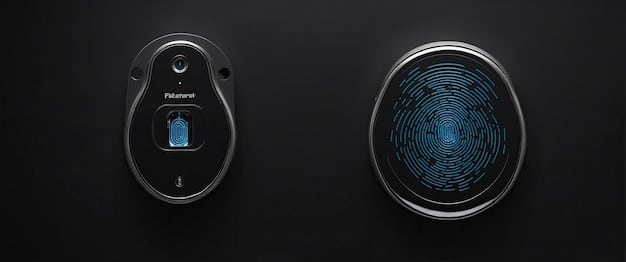
Decentralized Data Processing and Edge AI
To mitigate privacy risks associated with cloud storage, there’s a growing trend towards processing sensitive data at the “edge” – directly on the device. This approach enhances both privacy and speed.
- On-Device Facial and Voice Recognition: Instead of sending biometric data to the cloud for processing, calculations happen directly on the camera or microphone, minimizing exposure.
- Local Data Storage: For sensitive information like security camera footage or entry logs, homes prioritize local storage options, with cloud backup as an optional, encrypted layer.
- Reduced Latency: Processing data locally means quicker response times, as data doesn’t need to travel to and from the cloud, improving real-time system performance.
This shift ensures that sensitive personal data remains within the home network, reducing the risk of breaches and providing users with greater control over their information. Companies are increasingly transparent about how data is handled, empowering users to make informed choices. The emphasis is on giving homeowners authority over their data.
Ultimately, the future of smart homes hinges on trust. By investing in robust security protocols and prioritizing user privacy through advanced authentication and decentralized data processing, the industry aims to build confidence and foster widespread adoption. Homeowners in 2025 can expect devices that not only enhance their living experience but also safeguard their digital and physical safety with unparalleled sophistication.
Interoperability and Ecosystem Unification
The early days of smart homes were often characterized by a frustrating fragmentation of devices and platforms. In 2025, a significant trend is the relentless push towards enhanced interoperability and the unification of diverse ecosystems. This means that devices from different manufacturers will increasingly communicate seamlessly, creating a truly integrated and harmonious smart home experience. No more fighting with incompatible apps or protocols; the smart home of the future will simply “work together.”
The promise of a truly smart home has long been hampered by the “walled garden” approach of many manufacturers, leading to user frustration. However, 2025 marks a turning point as industry leaders and consumers alike demand universal compatibility. This shift simplifies setup, expands functionality, and enhances the overall value proposition of smart home technology. The goal is to move beyond mere connectivity to true collaborative intelligence amongst devices.
Matter and Other Universal Standards
A pivotal development is the widespread adoption of universal communication standards like “Matter.” This open-source connectivity standard simplifies direct communication between smart devices.
- Seamless Device Pairing: Matter-certified devices can easily connect to any Matter-compatible network, regardless of brand, making setup a breeze.
- Enhanced Reliability: By streamlining communication protocols, Matter reduces latency and improves the reliability of smart home ecosystems.
- Future-Proofing: Devices designed with Matter are more likely to remain compatible with future smart home innovations, protecting consumer investments.
This collaborative effort marks a significant step towards a truly unified smart home market, benefiting both consumers and manufacturers. Matter promises to bridge past divides, creating a cohesive and functional network.
Bridging Legacy and New Technologies
Interoperability extends beyond new devices; it also involves finding ways to integrate older, non-smart appliances into the modern smart home ecosystem. Adapters and hubs are playing a crucial role.
- Smart Plugs for Traditional Appliances: Simple smart plugs can convert traditional lamps, fans, or coffee makers into smart devices, controllable via app or voice.
- Universal Remote Hubs: Advanced hubs can translate signals from older infrared or radio frequency remotes, allowing their devices to be controlled by the main smart home system.
- Software Integration Layers: Developers are creating software solutions that act as bridges, allowing disparate systems to share data and trigger actions across platforms.
This backward compatibility ensures that homeowners don’t have to overhaul their entire setup to adopt new smart home trends, making the transition more accessible and cost-effective. The objective is to make smart homes inclusive, integrating both cutting-edge and existing technologies to work in concert.
The drive towards unification and interoperability is transforming the smart home market from a collection of isolated gadgets into a cohesive, intelligent network. In 2025, consumers can expect a smoother, more flexible, and ultimately more powerful smart home experience, where every device contributes to a single, harmonious intelligent environment. This makes smart home technology less intimidating and more approachable for a broader audience, fostering wider adoption.
Sustainability and Energy Efficiency at the Core
In 2025, the smart home movement is placing a heightened emphasis on sustainability and energy efficiency. Beyond mere convenience, these innovations are designed to minimize environmental impact, reduce utility bills, and promote a greener lifestyle. Smart homes are evolving from energy consumers to intelligent energy managers, contributing positively to both personal finances and planetary health.
The growing awareness of climate change and rising energy costs has propelled sustainability to the forefront of smart home development. Consumers are increasingly seeking solutions that not only automate their lives but also help them reduce their carbon footprint. This trend reflects a broader societal shift towards eco-conscious living, integrated directly into our daily habits through technology.
Intelligent Energy Management Systems
Smart homes are becoming sophisticated energy auditors and optimizers, providing homeowners with unparalleled control and insights into their consumption.
- Real-time Energy Monitoring: Devices provide granular data on energy usage by appliance, allowing homeowners to identify energy hogs and adjust accordingly.
- Predictive Energy Optimization: AI learns energy consumption patterns and external factors (e.g., peak utility rates, solar panel output) to automatically schedule tasks during off-peak hours or when renewable energy is abundant.
- Automated Load Shifting: Smart appliances can automatically defer energy-intensive tasks, such as laundry or dishwashing, to times when electricity is cheaper or cleaner.
These systems empower homeowners to make informed decisions about their energy use, leading to significant savings and a reduced environmental footprint. The emphasis is on proactive management, not just reactive reporting.
Integration with Renewable Energy Sources
Smart homes are increasingly designed to seamlessly integrate with and optimize the use of renewable energy.
- Smart Solar Integration: Systems can monitor solar panel output and battery storage levels, intelligently distributing power throughout the home or selling excess back to the grid.
- Electric Vehicle (EV) Charging Optimization: Smart homes can manage EV charging schedules to align with off-peak electricity rates or periods of high renewable energy generation.
- Smart Grid Interaction: Homes can communicate with the broader energy grid, participating in demand response programs that help stabilize the grid and utilize cleaner energy sources.
By acting as micro-grids, these homes contribute to a more resilient and sustainable energy infrastructure. The home becomes an active participant in the energy ecosystem, not just a passive consumer.
The commitment to sustainability in smart home technology is a defining characteristic of 2025. Innovations in intelligent energy management and renewable energy integration are not just features; they are foundational elements that are transforming homes into models of efficiency and environmental responsibility. This evolution ensures that smart living is synonymous with sustainable living, offering benefits that extend far beyond the front door.
Health, Wellness, and Elder Care Integration
Beyond convenience and security, smart homes in 2025 are increasingly prioritizing the health, wellness, and safety of their occupants, particularly for elderly individuals or those requiring special care. Innovations in this area focus on passive monitoring, proactive alerts, and seamless integration with healthcare services, transforming the home into a supportive and protective environment. This trend underscores a human-centric approach to technology.
The home is becoming a vital hub for personal well-being. From tracking sleep patterns to monitoring vital signs and detecting falls, smart home technology is being leveraged to promote healthier lifestyles and provide peace of mind for families. This proactive approach to health management within the home setting represents a significant step forward in personalized care.
Passive Monitoring and Early Detection
Advanced sensor technology allows for continuous, non-intrusive monitoring of health and activity within the home. This provides valuable insights without requiring wearables or active participation.
- Sleep Pattern Analysis: Non-contact sensors under mattresses or integrated into furnishings can track sleep stages, breathing, and heart rate, providing insights into sleep quality.
- Fall Detection Systems: Radar and motion sensors can detect falls without privacy-invading cameras, automatically alerting family members or emergency services.
- Air Quality and Environmental Sensors: Monitoring for pollutants, allergens, temperature, and humidity can help optimize the home environment for respiratory health and general comfort.
These systems offer a layer of invisible protection, providing peace of mind by identifying potential issues before they escalate. The aim is to create an unobtrusive safety net.
Proactive Wellness Coaching and Support
Smart homes are not just monitoring; they are also interacting to promote healthier habits and provide support.
- Personalized Lighting for Circadian Rhythms: Lights can adjust color and intensity throughout the day to support natural sleep-wake cycles, improving mood and productivity.
- Automated Hydration Reminders: Integrated water dispensers or smart water bottles can remind residents to stay hydrated based on activity levels or time of day.
- Medication Reminders and Dispensers: Smart devices can issue timely reminders for medication, and even automatically dispense doses, aiding adherence for chronic conditions.
This proactive engagement encourages healthier living and provides a supportive framework for daily routines, especially for those managing health conditions. The home becomes a personal health companion.
Emergency Response and Elder Care Services
For seniors living independently, smart home technology offers vital support for safe and connected living.
- Two-Way Communication Systems: Integrated voice assistants and video screens allow for easy communication with caregivers or emergency services directly from any room.
- Activity Monitoring for Routines: Systems can learn daily routines and send alerts if significant deviations occur (e.g., no activity in the kitchen by midday), indicating a potential problem.
- Remote Management for Caregivers: Authorized family members or caregivers can remotely monitor device status, adjust settings, and receive alerts, offering peace of mind.
These innovations empower elderly individuals to maintain their independence longer, while providing their families with assurance about their safety and well-being. The smart home becomes an extension of the care network.
The integration of health, wellness, and elder care features is making smart homes more than just convenient; they are becoming essential tools for supporting quality of life and providing critical assistance. In 2025, a truly intelligent home is one that cares for its occupants, proactively promoting well-being and ensuring safety across all life stages.
Immersive Experiences and Digital Ecosystems
The smart home of 2025 is moving beyond practical utility to deliver truly immersive and personalized digital experiences. This involves a deeper integration of entertainment, communication, and digital content, transforming living spaces into dynamic, responsive environments that cater to every mood and activity. The focus is on creating a seamless blend between the physical and digital worlds within the confines of your home.
No longer content with just controlling lights or thermostats, homeowners are seeking spaces that can adapt to provide rich sensory experiences. This might involve transforming a living room into a home theater with the push of a button, or creating a calming ambiance perfect for meditation. The goal is to make the digital experience feel naturally embedded within the physical architecture of the home.
Advanced Home Entertainment Integration
Entertainment systems are becoming fully integrated, offering cohesive experiences across different rooms and devices.
- Dynamic Soundscapes: Multi-room audio systems can create immersive sound environments, adapting sound levels and direction based on user movement or specific activities.
- Integrated Projection and Display Walls: Walls can become dynamic displays, projecting movies, artwork, or virtual landscapes, blurring the lines between physical space and digital content.
- Adaptive Lighting for Media: Lighting systems synchronize with media content, adjusting colors and brightness to enhance movies, games, or music, creating truly immersive experiences.
These innovations elevate home entertainment to a new level, making every viewing or listening experience uniquely engaging and dynamic. You’re not just watching a movie; you’re living it.
Seamless Communication and Telepresence
The lines between in-person and remote interactions are blurring, with smart homes facilitating more natural and immersive communication.
- Holographic Projection (Early Stages): While still in nascent stages, early forms of holographic projection or advanced AR/VR integration might offer novel telepresence experiences for calls and meetings.
- Ambient Communication Hubs: Smart displays and speakers become more integrated into walls or furniture, providing discreet yet ever-present access to video calls and messages.
- Multi-room Intercom Systems: Enhanced intercom features allow for seamless communication between family members across the house, or even with visitors at the front door.
These advancements make remote work, education, and staying connected with loved ones more natural and less intrusive, enhancing the quality of virtual interactions.
Adaptive Sensory Environments
The smart home can create specific sensory environments designed to promote relaxation, productivity, or creativity.
- Personalized Scent Diffusion: Integrated systems can release customized scents based on time of day, desired mood (e.g., calming lavender for bedtime, invigorating citrus for mornings). These can even be tied to emotional cues or activities.
- Dynamic Artwork and Visuals: Digital art frames and projection systems can display an endless array of visual content, from calming nature scenes to vibrant abstract art, transforming the aesthetic of a room instantly.
- Acoustic Optimization: Rooms can dynamically adjust their acoustic properties to suit different activities, such as dampening echoes for clearer conference calls or enhancing bass for movie nights.
These immersive features turn the home into a truly adaptive canvas for daily life, providing rich, multi-sensory experiences that respond to the occupants’ needs and desires. The smart home in 2025 is not just about automation, but about artfully blending technology with experience to craft a truly unique living environment.
| Key Point | Brief Description |
|---|---|
| 💡 Proactive AI | Smart homes anticipate needs, automating tasks like temperature adjustments and lighting based on learned behaviors and external data. |
| 🤝 Interoperability | Universal standards like Matter ensure devices from different brands work seamlessly together, simplifying home automation. |
| 🌿 Sustainability Focus | Intelligent energy management and renewable energy integration reduce environmental impact and lower utility costs. |
| ❤️ Health & Wellness | Passive monitoring, fall detection, and personalized wellness support enhance safety and promote well-being for all ages. |
Frequently Asked Questions About Smart Home Trends in 2025
Proactive AI refers to smart home systems that anticipate your needs and automate actions without explicit commands. It learns your routines, preferences, and external factors (like weather or traffic) to adjust settings, optimizing comfort and efficiency before you even realize it’s necessary. This moves the smart home beyond responsive commands to intuitive predictions.
Matter is an open-source connectivity standard designed to unify smart home devices from different manufacturers. It enables seamless communication among various brands and ecosystems, simplifying device setup and ensuring devices are compatible with a broader range of smart home platforms. This significantly reduces fragmentation and user frustration often associated with diverse smart gadgets.
Smart homes in 2025 integrate intelligent energy management systems that monitor and optimize consumption. They can connect with renewable energy sources like solar panels and interact with smart grids to reduce environmental impact. Features include predictive energy optimization, load shifting, and real-time monitoring, helping homeowners lower their carbon footprint and save on utility costs.
Smart home innovations for health and wellness include passive monitoring of sleep patterns and air quality, and advanced fall detection systems. They also offer proactive wellness coaching through personalized lighting for circadian rhythms, automated hydration reminders, and critical support for elder care such as medication reminders and two-way communication systems, ensuring a safer and healthier living environment.
Absolutely. Smart homes in 2025 are designed for immersive experiences, integrating advanced home entertainment. This involves dynamic soundscapes with multi-room audio, integrated projection systems that turn walls into displays, and adaptive lighting that synchronizes with media content. This creates a highly engaging and personalized sensory environment, transforming standard home entertainment into a captivating experience.
Conclusion
The rapid evolution of smart home technology promises to redefine our living spaces by 2025. What began as a collection of isolated gadgets is maturing into a cohesive, intelligent ecosystem driven by proactive AI, seamless interoperability, and a deep commitment to sustainability. These advancements are not merely about convenience; they are about fostering more personalized, secure, and environmentally conscious environments. As homes become increasingly intuitive and responsive to our individual needs and the broader world, the future of home automation truly looks promising, offering unprecedented levels of comfort, efficiency, and well-being.
